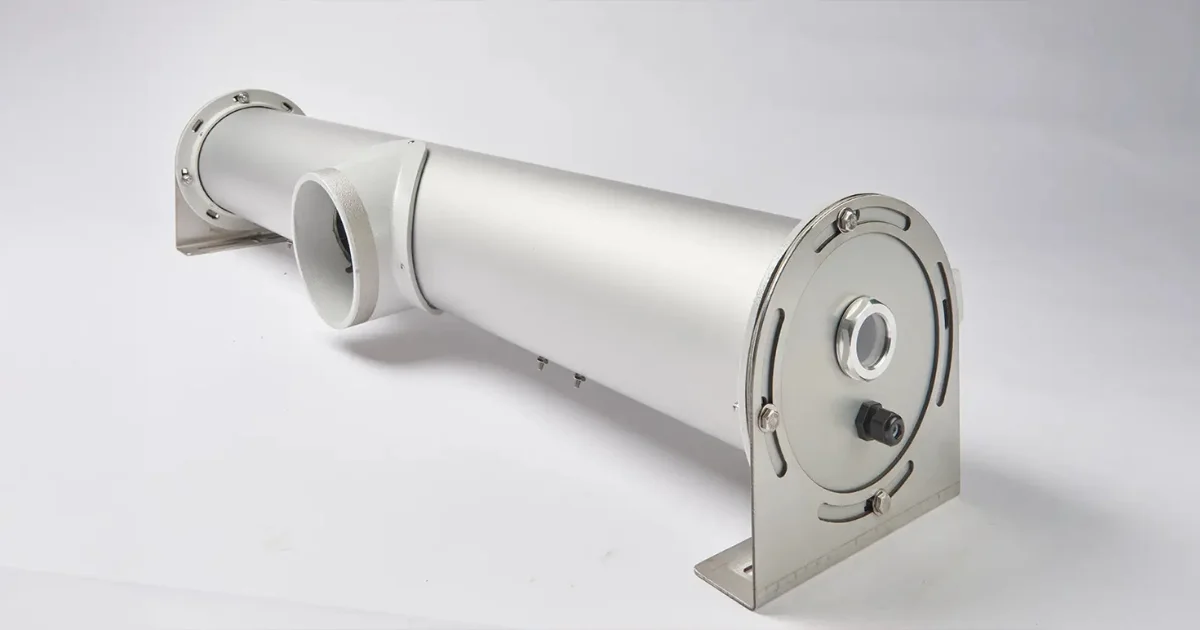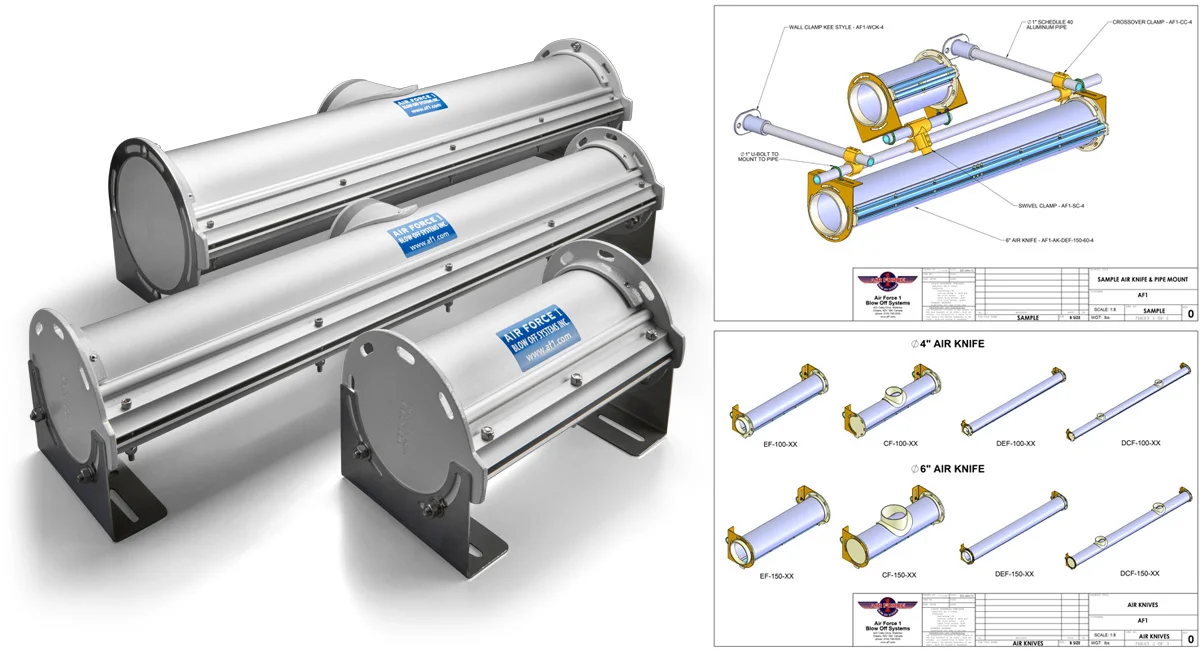
If you've worked around production lines, you've likely seen an air knife in action – a sleek metal device creating a precise curtain of high-speed air. These tools are essential in industries ranging from food processing to automotive manufacturing, where cleaning and drying products efficiently is crucial. Air knives are versatile and come in various types, each designed to meet specific production needs.
The concept is both simple and effective. Rather than relying on physical brushes or wipes that can cause damage, air knives use a steady stream of air to remove water, dirt, or debris. This contact-free method ensures no scratches, no damage to surfaces, and no cross-contamination between products.
At AF1, air knives are an integral part of the manufacturing solutions we provide. Whether you're operating a food plant that requires spotless containers or preparing auto parts for painting, understanding how air knives work is essential. Let’s take a closer look at how these systems function and why they are indispensable in modern production lines.
The Basics of Air Knife Technology
What's an Air Knife?
Imagine a precision tool that generates a razor-sharp curtain of high-speed air. This is the essence of an air knife – a system specifically designed to clean, dry, or cool products as they move along a production line. Air knives are commonly used to sweep water off cans before labeling, cool hot extrusions, or protect critical components by keeping contaminants at bay.
The Parts That Make It Work
Every air knife system is made up of five essential components:
The blade – designed to transform moving air into a uniform, high-speed sheet.
An air source – either blowers or compressed air, depending on the application.
Controls – used to adjust the speed and pressure to match the specific task.
Mounting hardware – ensures the air knife is positioned exactly where it is needed.
Ducting – channels the air efficiently to the blade.
How They Work
The process begins with the air source pulling in ambient air. That air gets pressurized and flows through the ducting system to the knife blade. The blade’s precision design transforms the moving air into a uniform sheet – think of it like a waterfall, but with air instead of water.
When that sheet of air hits your product, it sweeps across the surface with exactly the force needed for your application. For example, to dry delicate electronics, you can adjust the system to use gentle pressure. If you’re blasting heavy debris off steel, you can increase the intensity. The system maintains consistent force hour after hour, making it ideal for today’s high-speed production lines.
Types of Air Knives

Blower-Powered Air Knives
When high-volume air with minimal pressure is required, blower systems are the go-to choice. They efficiently move large amounts of air, making them perfect for drying expansive surfaces or removing lightweight contaminants. Most plants favor these systems due to their lower operating costs and reduced energy consumption.
Compressed Air Knives
For tasks that demand more power, compressed air knives deliver the necessary force. They excel in challenging jobs, such as removing stubborn debris or drying products at very high line speeds. While they consume more energy than blower systems, their effectiveness in specific scenarios makes them indispensable.
Custom Solutions
Every production line comes with unique challenges, which is why custom air knives are often essential. These tailored solutions can include adjustable gaps, specialized mounting options, or uniquely angled blades to accommodate irregularly shaped products or tight spaces. Customization ensures the air knife performs optimally for specific requirements.
Choosing the right air knife type depends on factors such as application, line speed, and power needs. Many facilities find that a mix of air knife types provides the most efficient solution for their diverse operations.

Advantages of Air Knife Technology
Smart Power Use
Air knives, particularly blower-powered systems, are highly energy efficient. These systems allow operators to adjust air pressure and flow precisely, ensuring that no energy is wasted. Compared to compressed air systems that often run at full capacity, air knives can reduce energy costs significantly.
Many facilities report a noticeable drop in energy bills after making the switch to air knife technology, making it a cost-effective solution for long-term use.
Works for Almost Anything
One of the standout features of air knives is their versatility. They excel at a wide range of tasks, from drying freshly washed products to cooling hot materials and removing dust before packaging. With adjustable settings, a single air knife can handle multiple production challenges, eliminating the need for additional equipment and reducing overall operational costs.
No-Touch Operation
Air knives operate without making physical contact with products, which is a game-changer for quality control. This eliminates the risk of scratches, marks, or other surface damage. Industries such as electronics and automotive manufacturing benefit greatly from this no-touch feature, ensuring products meet high-quality standards while maintaining their integrity.
Precise Results Every Time
Air knives deliver uniform airflow across the entire width of the product. This precision ensures that every part of the product is treated equally, leaving no room for missed spots or inconsistencies. In industries with stringent cleanliness requirements, such as food processing and medical device manufacturing, this level of precision is essential for compliance and quality assurance.
Built to Last
Designed for industrial use, air knives are built with durability in mind. With few moving parts, these systems experience minimal wear and tear, leading to reduced maintenance needs and extended operational lifespans. Their robust construction makes them reliable even in demanding environments, ensuring consistent performance over time.
Better for the Environment
Air knives offer an eco-friendly alternative to traditional cleaning and drying methods. They eliminate the need for harsh chemicals and rely solely on air to perform their tasks. Additionally, their energy efficiency contributes to a smaller carbon footprint, aligning with the growing emphasis on sustainability in industrial operations. By reducing energy consumption and chemical waste, air knives support both environmental and regulatory goals.
These advantages demonstrate why air knives are becoming the preferred choice for modern production lines. Their combination of efficiency, versatility, and reliability makes them a valuable investment for any facility.
Applications of Air Knives
Manufacturing
In the manufacturing sector, air knives play a critical role in preparing surfaces for finishing processes. For example, paint shops use air knives to remove every speck of dust and drop of moisture from car parts before applying paint. This ensures a flawless finish that meets the high standards of automotive production. Similarly, air knives are employed in electronics manufacturing to keep delicate circuit boards clean and free of contaminants, where physical contact could cause damage.
Food and Beverage
Air knives are indispensable in food and beverage production. They ensure that cans and bottles are completely dry before labels are applied, preventing peeling or misalignment. Additionally, air knives gently clean fruits and vegetables, removing dirt and debris without causing bruising or other damage. This level of precision helps maintain the quality and safety of food products, meeting the strict hygiene standards of the industry.
Pharmaceuticals
In the pharmaceutical industry, air knives are essential for maintaining sterility and cleanliness during packaging processes. They are used to keep blister packs, vials, and other packaging materials free from dust and moisture, ensuring compliance with rigorous FDA standards. The no-touch operation of air knives is particularly valuable in this field, where contamination risks must be minimized.
Printing and Packaging
In printing, air knives expedite the drying of ink, enabling presses to operate at high speeds without compromising quality. In packaging, they remove debris and moisture that could interfere with sealing processes, ensuring that packages are clean and airtight. This is especially important for products that require long shelf lives or are sensitive to environmental factors.
Air knives are also used in a variety of other industries, from textiles to aerospace, wherever precise cleaning and drying are required without direct contact. Their versatility and efficiency make them an essential tool in modern production environments.
Factors to Consider When Choosing an Air Knife
Material Selection
The material of the air knife blade is critical to its performance and longevity. For food and beverage applications, stainless steel is the preferred choice due to its resistance to corrosion and ease of cleaning. For less demanding environments, aluminum blades offer a cost-effective alternative while maintaining durability.
Size and Coverage
Ensuring that the air knife provides adequate coverage for your products is essential. Measure the width of your production line and choose an air knife that offers complete coverage without significant oversizing, which can lead to unnecessary energy consumption.
Air Source
Blower systems are often the most energy-efficient choice for air knives, especially in applications requiring high airflow with minimal pressure. However, compressed air systems may be necessary for tasks requiring greater force. Evaluate your application’s needs to determine the most suitable air source.
Noise Levels
Noise can be a significant concern in industrial environments. Choose air knife systems designed to minimize noise output to create a safer and more comfortable workplace for employees while meeting OSHA noise level standards.
Environmental Conditions
Consider the specific conditions of your facility. If the air knife will be used in a corrosive or high-humidity environment, opt for materials and designs that can withstand these challenges. For outdoor applications, weather-resistant features are essential to ensure reliable performance.
By carefully evaluating these factors, you can select an air knife system that meets your production needs while optimizing efficiency and minimizing operational costs.
Conclusion
Air knives have become an indispensable tool in modern production environments, offering unparalleled efficiency, precision, and reliability. Whether in food processing, automotive manufacturing, or pharmaceutical packaging, their versatility ensures they can handle a wide range of applications with ease.
The benefits of air knives extend beyond their immediate functionality. By reducing energy consumption, eliminating the need for harsh chemicals, and offering no-contact operation, they contribute to sustainability and improved workplace safety. Companies that invest in air knife technology often see significant improvements in product quality, operational efficiency, and overall cost savings.
With the right air knife system, your facility can achieve new levels of productivity and performance, meeting the demands of today’s competitive industries.
Contact us if you are ready to enhance your production line with cutting-edge technology.

